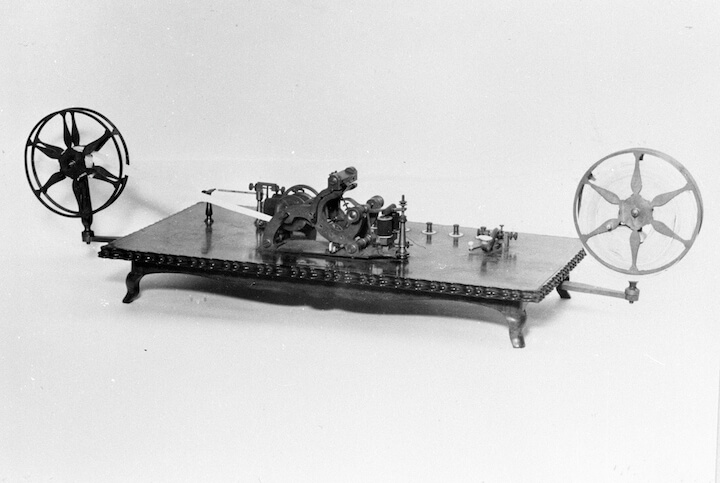
2021.10.26
















magazine
2021.10.26

The key concept for Kyoto Experiment Autumn 2021 is “moshi moshi?!” Due to the pandemic online dialogues have become more frequent and we often find ourselves addressing an absent body that does not exist in the same space. Should we not therefore ask, how to listen to the voices of others who are / are not here and the sounds that are / are not currently occurring. Who is the subject that calls out “moshi moshi?!”, or is one being called? And how do you imagine the invisible on the other side of “moshi moshi?!” The next pages feature articles from a variety of different perspectives, all using the key concept “moshi moshi?!” as a starting point.
The smartphone placed in front of me starts to ring. I answer and hear: “Moshi moshi?” I also answer, “Moshi moshi.” Silence. What should I do? From then, I just start listening to Samuel Beckett’s Not I (1972) performed—or is it narrated?—on the other end of the line. When I tire of Beckett’s difficult, repetitive language, as if having detected this, along comes another moshi moshi, though not in the original script, to quickly refocus my concentration. At any rate, it was addressed to me alone.
In the midst of the pandemic, this performance by telephone, Moshi-Moshi, Not I, was devised by Kamome Machine’s artistic director, Yuta Hagiwara. The narrator was actor Honami Shimizu. Though premiered in September 2020, I received the phone call at a little after 6 p.m. on August 2nd, 2021, while I was in the otherwise empty second-floor exhibition space of the Tsubouchi Memorial Theatre Museum at Waseda University.
It was a peculiar physical experience, though perhaps because it felt like an invitation to what was, in a sense, a violent one-on-one relationship, I ended up deploying a kind of defense mechanism of avoidance by taking in the exhibits as I listened to the words from the other end of the line. But eventually, my body seemed to reach a state whereby it could concentrate on the voice speaking through my smartphone and I sat on a chair in the corridor outside the exhibition room and listened until the end.
In its original conception, the performer would call individuals on their own mobile phones, but this version, presented as it was as part of the museum’s exhibition, was somewhat different. The Tsubouchi Memorial Theatre Museum was then holding the exhibition “Lost in Pandemic—Theatre Adrift, Expression’s New Horizons” (June 3rd–August 6th, 2021). The performance was arranged to start just after the museum’s closing time, when you could still view the main exhibition space but the video exhibits were no longer playing. Nonetheless, you could take in the materials for stage performances canceled or postponed due to the pandemic, from posters to costumes, models of stage sets, and scripts, along with a detailed timeline. The exhibits also included an introduction to Moshi-Moshi, Not I, where a smartphone was placed all alone. At the appointed time, the phone would ring and the performance would begin.
Hagiwara has written about the performance in a superb essay, “Why Telephone Theater? Creating the Public from a Gloomy Place,” published on note.com on July 16th, 2021, and I have little further to add.1 But I would like to emphasize here that in terms of the fundamental issue, regardless of the pandemic or not, what Hagiwara is doing is confronting the question of “What is theater?” while proposing a new concept of the public through this distinct format of telephone theater.
The majority of the exhibits at “Lost in Pandemic,” at least those I saw, were materials related to performances “lost” due to cancellation or postponement. The detailed timeline was well put together and exhibition also quite quickly (on June 30th) released an eponymously titled tie-in publication, comprising for the most part a historically valuable collection of essays, rather than the usual content of an exhibition catalogue.
But in this time, have Japanese-language theater practices aspired for the “new horizons” cited in the exhibition’s subtitle? The exhibition’s final section introduced a very small number of examples, including Moshi-Moshi, Not I, and yet, speaking from my own personal experience during the pandemic, such endeavors have been almost nonexistent in terms of the so-called industry as a whole.
An economic support network, the Japan Performing Arts Solidarity Network, did indeed form, bringing together many interested parties and attracting attention for its tactics of direct action like lobbying the government, but this was, at the end of the day, a response akin to conformity so that everyone could survive until things went “back to normal.” No, far from just going “back to normal,” the result of regarding theater self-evidently as a live performance held in the closed space that is a theater venue was that, precisely because of the pandemic, a sense of twisted entitlement highly valorizing a return to “normality” became widespread. This seemed like history repeating itself: in the early days of cinema at the start of the twentieth century or the digital era at the end of the twentieth century, theater sought to tackle its inferiority as a medium by asserting its self-evident value as live performance.
As is already clear, Moshi-Moshi, Not I was a critical response to this situation. But of far greater importance is that it is a response also at the fundamental level of the question of “What is theater?” explored during the pandemic, which is much, much more immediate than the metaconcept of a “new public” that Hagiwara seems to discuss. Participating in Moshi-Moshi, Not I, I could not help but recall the argument, quickly shared in Japan, of the Italian philosopher Giorgio Agamben about the pandemic in Europe and the process by which that was suppressed as a tiny minority voice.
Agamben’s series of remarks are already available in Japanese in book form.2 To make an admittedly rough summary, my understanding of what Agamben is saying in this book is that he wouldn’t mind dying from COVID if personal liberties (private rights) were taken from him. If “wouldn’t mind dying” is going too far, let’s say he is inciting us to fully resist those in power, who are attempting to take away our private rights under the pretext of the pandemic. But as I wrote above, almost the entire theater world appeared to me to exist this past year and a half in a state of conformity synonymous with self-constraint—that is, renouncing one’s private rights. To wit, I was left in doubt if there was an Agamben among Japanese-language theater practitioners.
That doubt was cleared up after experiencing Moshi-Moshi, Not I: there does seem to be one. In this way, while referring to Agamben, I became ready to think together with Hagiwara (and the others who presumably exist), regardless of the pandemic, about theater and the public—that is to say, the problem of the other and the essential violence of the theater form—through the active and passive call that is moshi moshi. Though admonishing myself for my thorough modernism, I can’t go along with the prevalent “J”-style strategy of surviving while balancing the premodern with the postmodern. For me, such as I am, “moshi moshi?!” is the most creative theme right now.
1. https://note.com/kamomemachine/n/n7b5fb00f22ae
2. Giorgio Agamben, Where Are We Now?: The Epidemic as Politics (2020, English trans. 2021, Japanese trans. 2021).
Tadashi Uchino
Tadashi Uchino, PhD, was born in Kyoto in 1957. He received his master’s degree from the Graduate School of Humanities and Sociology, the University of Tokyo. A specialist in culture and representation studies, he currently teaches at Gakushuin Women’s College. His publications include The Melodramatic Revenge (1996), From Melodrama to Performance (2001), and The Location of “J” Theatre (2016).